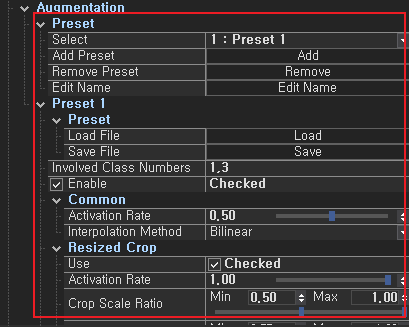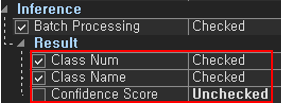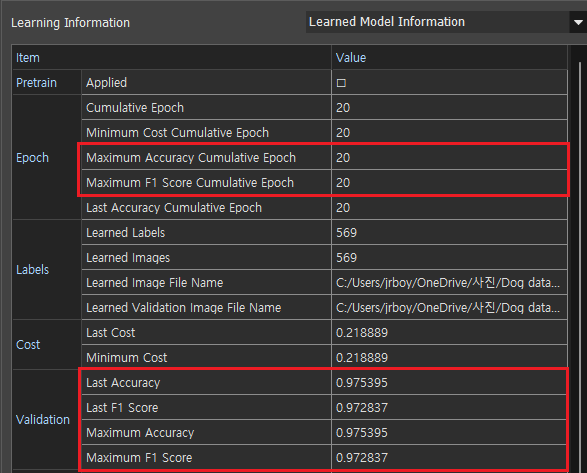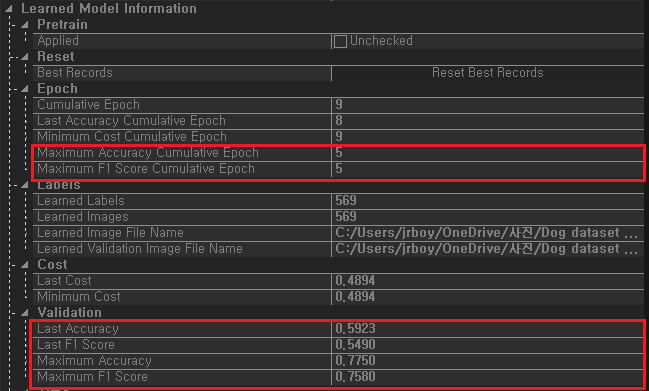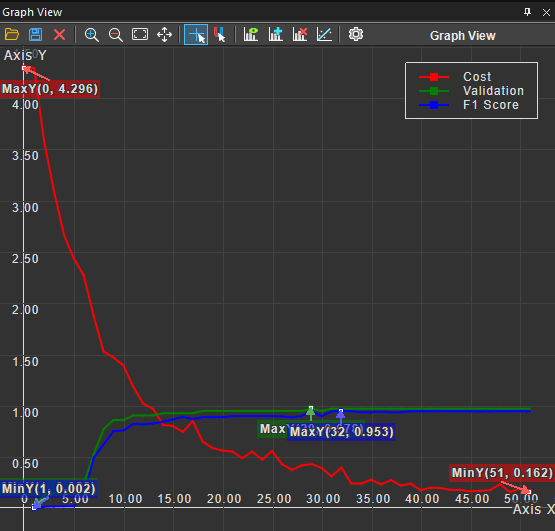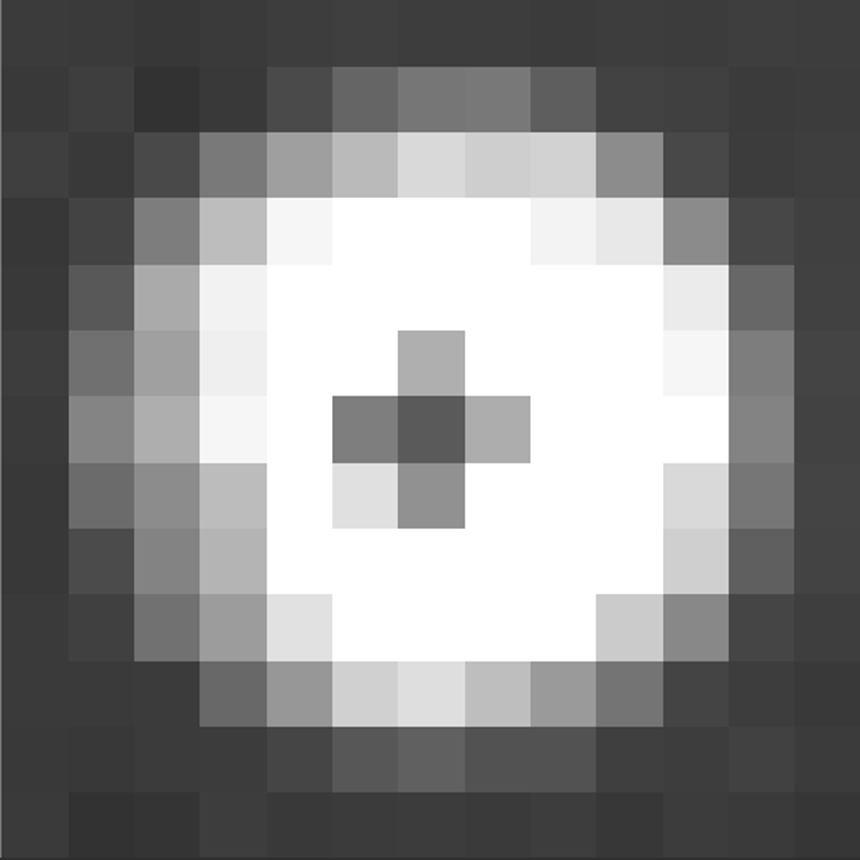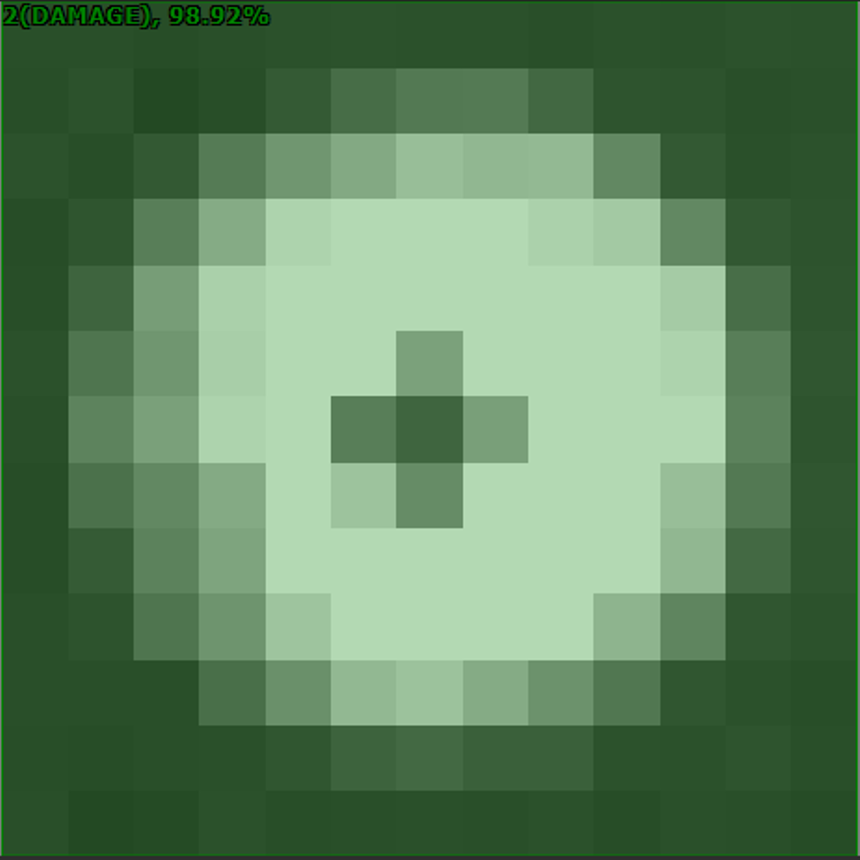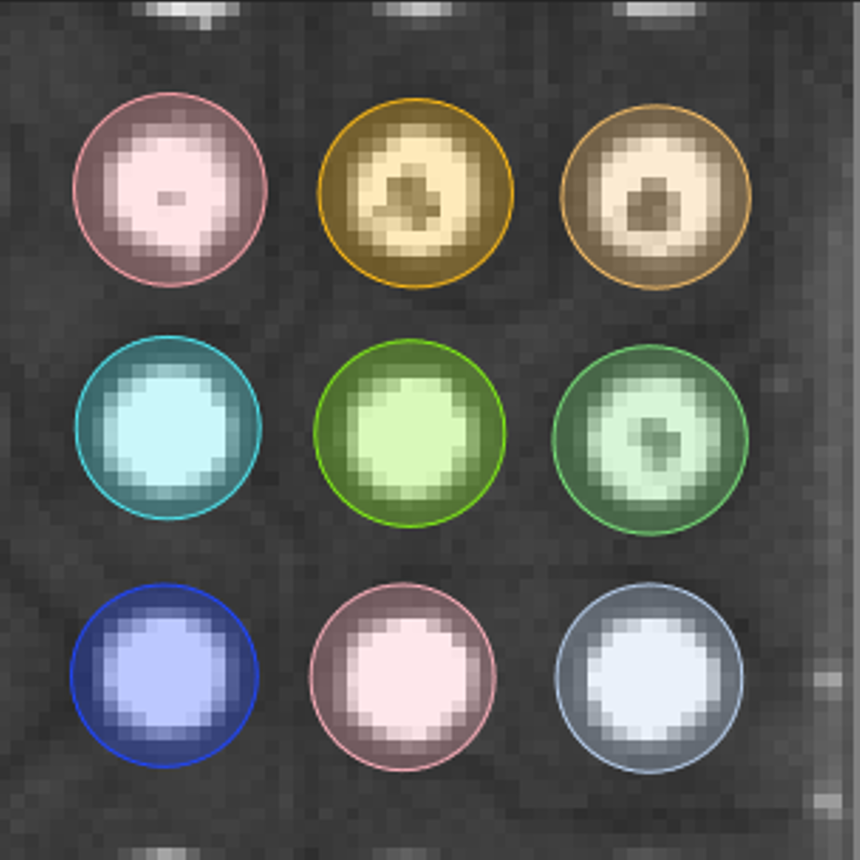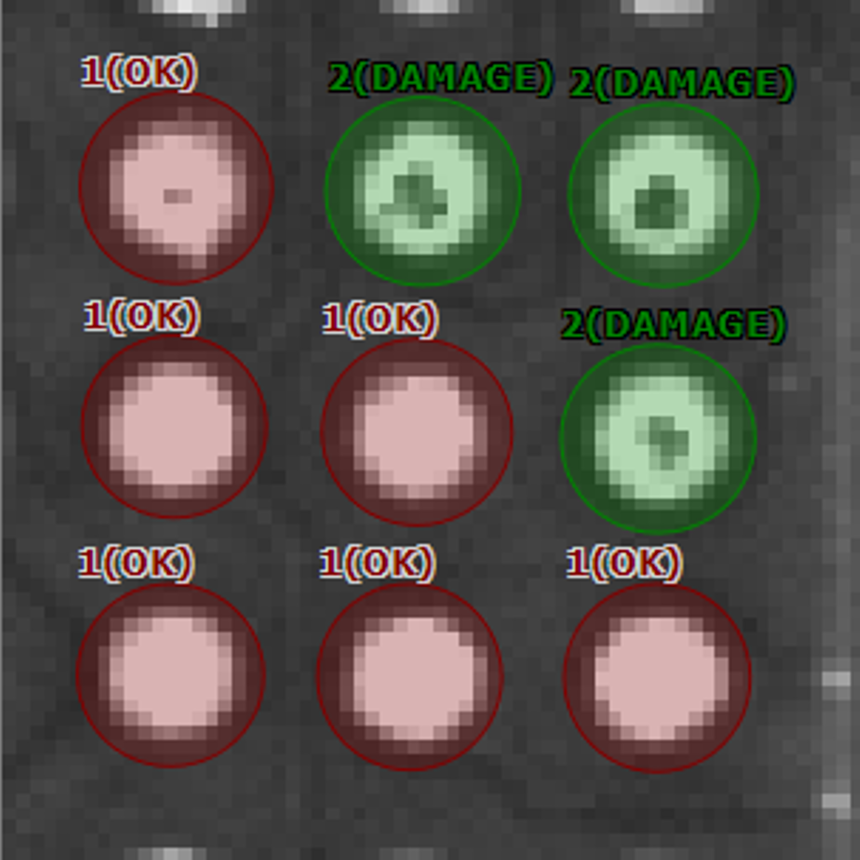Classifier DL
1 개요
- Classifier 알고리즘은 데이터나 개체를 특정 범주나 클래스에 할당하는 작업을 수행하는 머신 러닝 알고리즘입니다. 주로 분류를 하는데 사용되며, 다양한 분야에서 활용이 가능합니다. 대표적으로 MNIST와 같은 손글씨 숫자를 인식할 때나 주어진 이미지에 대해 특정 객체로 식별할 때 Classifier를 사용할 수 있습니다.
- FLImaging®의 Classifier DL에서는 자체적으로 개발한 우수한 성능의 모델인 FL_CF_C나 FLNet을 제공하고 있으며, 그 밖에도 많이 사용되는 VGGNet-16, ResNet-50, Inception-v1 등 잘 알려진 모델 또한 사용할 수 있습니다.
2 Classifier 사용 방법
1 데이터 셋 준비
-
MNIST와 같이 전체 이미지를 분류 범주로 나눌 경우는 학습 이미지로 들어온 파일 이름을 파싱하여 맨 앞의 숫자를 기준으로 labeling 하여 학습을 진행합니다.
- 해당 방식으로 라벨링을 하고 싶은 경우 동일한 카테고리의 이미지들이 담겨있는 폴더 이름만 설정하여 일괄적으로 처리가 가능합니다.
- 아래와 같이 폴더 이름을 앞에 카테고리 번호로 설정한 후 폴더를 이미지 뷰어에 로드하거나 폴더 경로를 학습 이미지로 설정하면 아래와 같이 번호를 label number로 인식하여 학습을 진행합니다.
- 아래의 예시에서 원래 파일 이름은 "241.jpg" 였지만, 해당 파일이 들어있는 폴더를 로드하면 폴더 앞의 번호가 1이기 때문에 1과 _이 삽입되어 "1_241.jpg"를 이름으로 뷰어에서 인식하게 됩니다.

Fig. 폴더 이름으로 카테고리 분류
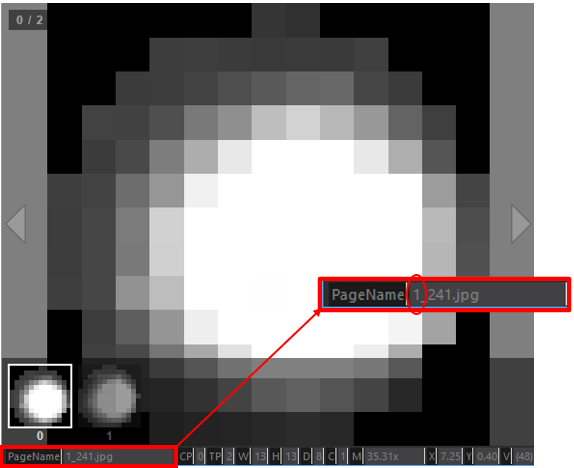
Fig. 폴더 안에 있는 이미지들의 Page name
- 또 다른 방식은 아래와 같이 이미지 내에 분류하고 싶은 영역에 대해 ROI를 설정하면, Crop 없이 학습이 가능합니다.
- Labeling은 figure의 name을 설정하여 category 분류를 할 수 있습니다.
- 이때 figure name은 위와 같이 해당 항목의 번호 + (항목 이름)으로 저장하면 파싱하여 figure name 앞의 번호는 class number로 처리하고, 괄호 안의 이름은 class name으로 인식하여 아래와 같이 learned label이 처리된 것을 확인할 수 있습니다.
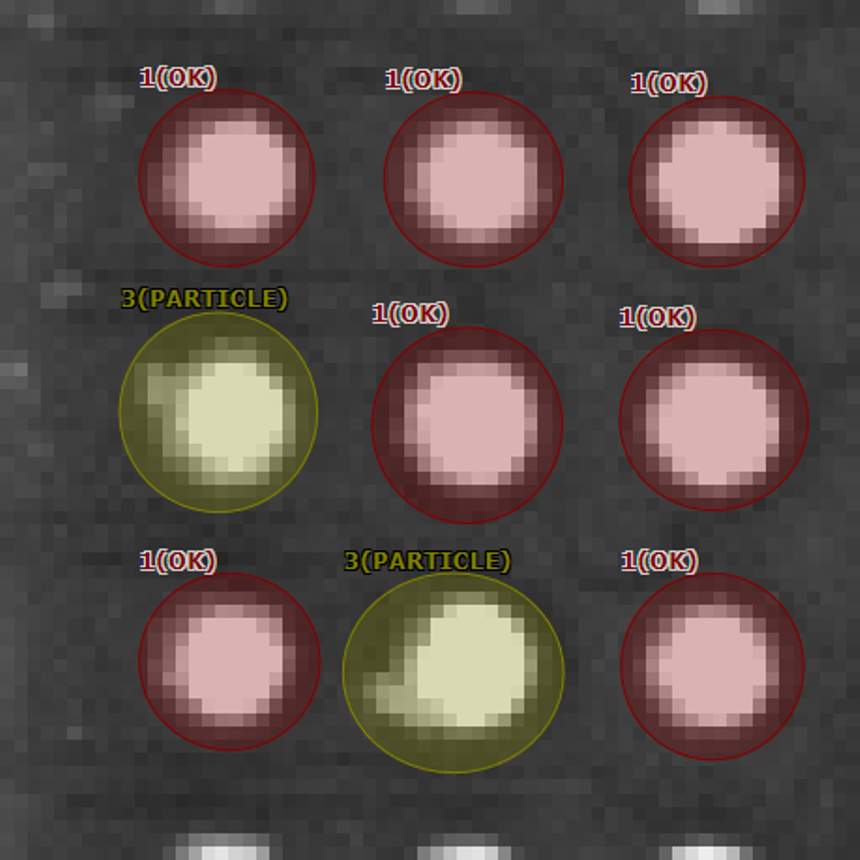
Fig. Figure을 사용한 Labeling
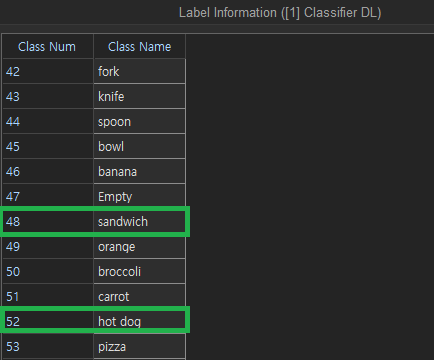
Fig. 학습 후 분류된 카테고리에 대한 정보 출력
2 학습
2.2.1. 학습 이미지 설정
2.2.2. 검증 이미지 설정(선택)
- 검증 지표
- F1 Score(Metric)
- 정밀도(Precision)와 재현율(Recall)을 사용하는 평가 지표입니다.
- 정밀도
- 분류 모델이 Positive로 판정한 것 중, 실제로 Positive인 샘플의 비율입니다.
- Positive로 검출된 결과가 얼마나 정확한지를 나타냅니다.
- 계산하는 식은 아래와 같습니다.
- 재현율
- 실제 Positive 샘플 중을 모델을 통해 Positive로 판정한 비율입니다.
- 분류 모델이 실제 Positive한 클래스를 얼마나 빠지지 않고 판정하는지를 나타냅니다.
- 계산하는 식은 아래와 같습니다.
- 정밀도
- 각 클래스 별 정밀도와 재현율을 구하여 아래의 식과 같이 F1 score를 구합니다.
- 정밀도와 재현율이 높을수록 더 높은 값이 나오고, 클래스별 데이터가 불균형하여도 해당 지표가 높다면 신뢰할 수 있다고 할 수 있습니다.
- 정밀도(Precision)와 재현율(Recall)을 사용하는 평가 지표입니다.
- Accuracy(Validation)
- Validation 데이터에 대한 전체 예측 중 정확하게 분류한 객체들의 분류입니다.
- 계산하는 식은 아래와 같습니다.
- 계산하는 식은 아래와 같습니다.
- 클래스별 데이터가 균형적이라면 이 지표는 충분히 의미가 있습니다.
- 클래스별 데이터가 불균형한 Validation 데이터라면 해당 지표가 높아도 신뢰도가 떨어질 수 있습니다.
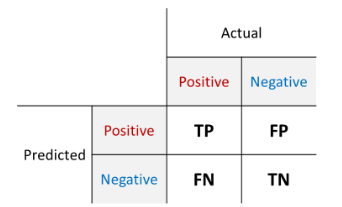
Fig. Confusion Matrix - Validation 데이터에 대한 전체 예측 중 정확하게 분류한 객체들의 분류입니다.
- F1 Score(Metric)
2.2.4. 옵티 마이저 설정
2.2.5. Augmentation 설정(선택)
- Classifier는 Augmentation 유형 중에서 Mix Method(ObjectMix, CutMix, MixUp, Mosaic)은 지원하지 않습니다.
2.2.6. 학습 수행
- Classifier는 객체에 대한 분류 알고리즘이기 때문에 다른 AI 알고리즘에 비해 validation 값이 1로 수렴하는 것이 용이합니다.
- 따라서 최대한 좋은 학습 결과를 얻고 싶다면 validation 값이 1이면 학습을 종료하도록 stop condition을 설정하는 것을 권장합니다.
- 추천 종료 조건
accuracy >= 1 || f1score >= 1
2.2.7. 조건 식
- 종료 조건(Stop Condition) & 자동 저장(Auto Save)에서 사용 가능한 조건 식 입니다.
- Common Conditional Expression
- Classifier Conditonal Expression
변수명 설명 Stop Condition 예시 Auto Save 예시 f1score, f1, f1score F1-Score 지표입니다. 정밀도(Precision)와 재현율(Recall)을 이용한 조화 평균입니다. 정밀도와 재현율이 모두 높아야 높은 값이 나옵니다. 0 ~ 1 범위를 가지며 1로 갈수록 좋은 결과를 나타냅니다. cost <= 0.3 & f1score >= 1 epoch >= 10 & f1score >= max('f1score') & f1score > 0 accuracy 정확도 입니다. 맞춘 개수 / 총 개수 로 계산 되어집니다. 0 ~ 1 범위를 가지며 1로 갈수록 좋은 결과를 나타냅니다. cost <= 0 | accuracy >= 1 epoch >= 10 & accuracy >= max('accuracy') & accuracy > 0 metric F1score가 metric으로 사용됩니다. cost <= 0 | metric >= 1 epoch >= 10 & metric >= max('metric') & metric > 0 validation accuracy가 validation으로 사용됩니다. cost <= 0 | validation >= 1 epoch >= 10 & validation >= max('validation') & validation > 0 - GUI 에서 설정 방법
- 종료 조건 식 설정
cost <= 0 | validation >= 1 | metric >= 1

Fig. GUI에서 종료 조건 설정 - 자동 저장 조건 식설정
epoch >= 10 & metric >= max('metric') & metric > 0
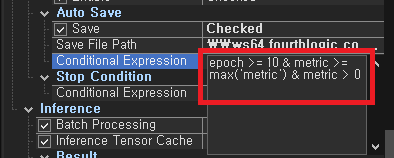
Fig. GUI에서 자동 저장 조건 설정
- 종료 조건 식 설정
3 추론
4 Save/Load
- Save/Load
- 모델파일을 저장하거나 불러옵니다.
- 확장자는 .flcf입니다.
3 필수 옵션
1 Learn 이미지 설정
2 모델 설정
1 모델/버전
- Classifier DL에서 사용할 모델 및 모델의 버전을 설정합니다.
- 모델의 크기도 결정됩니다.
- 지원 모델
- FLNet(V1 32 B1~B3/V1 64 B1~B3/V1 128 B1~B3/V1 256 B1~B3)
- 포스로직에서 개발 복잡한 Dataset에 대해서도 좋은 성능을 내는 모델입니다. 사용자의 선택에 따라 네트워크 깊이 및 input size를 조절하여 더 정교한 학습을 가능하게 합니다.
- FL CF C(V1 32/V1 64)
- 포스로직에서 자체적으로 개발한 모델로 상대적으로 단순한 MNIST와 같은 데이터셋에 대해 적합합니다. Input size가 크지 않기 때문에 다른 모델들에 비해 한 epoch 당 training 속도가 빠릅니다.
- FLNet FPT(FLSegNet V1 B1~B5/R-FLNet V1)
- 다른 알고리즘에서 사용하는 모델을 Classifier에 맞게 변형한 버전입니다. 포스로직만의 효율적인 최신 AI 모델 설계 구조를 바탕으로 구현된 정밀한 결과를 도출합니다.
- ResNet(L50 224)
- VGGNet(V1 224)
- AlexNet(V1 227)
- LeNet(V1 28)
- Inception(V1 224)
- FLNet(V1 32 B1~B3/V1 64 B1~B3/V1 128 B1~B3/V1 256 B1~B3)
2 API
SetModel(EModel eModel = EModel_FL_CF_C)eModel: 학습에 사용할 모델을 설정합니다.
SetModelVersion(EModelVersion eModelVersion = EModelVersion_FL_CF_C_V1_32)eModelVersion: 학습에 사용할 모델의 버전을 설정합니다. Input size 및 block의 개수 등을 설정할 수 있습니다. -1인 경우 최신 버전을 사용합니다.
3 예제 코드
CClassifierDL classifierDL;
classifierDL.SetModel(CClassifierDL::EModel_FLNet);
classifierDL.SetModelVersion(CClassifierDL::EModelVersion_FLNet_V1_256_B3);
4 GUI에서 설정 방법
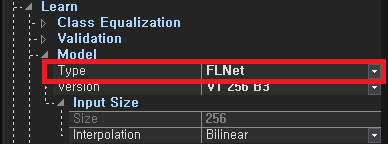
Fig. GUI에서 사용할 모델을 설정하는 Dropdown List
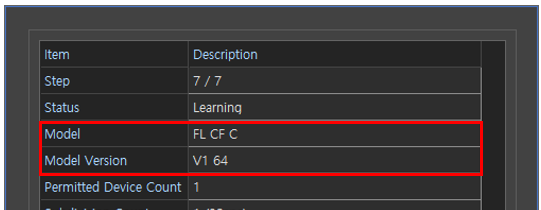
Fig. GUI에서 사용할 모델 버전을 설정하는 Dropdown List
3 추론 필수 옵션
4 선택 옵션
1 학습 선택 옵션
- 검증 이미지 설정
- 검증 이미지를 설정합니다. 검증 이미지는 라벨링이 되어있어야 합니다.
- 검증 옵션 설정
- 옵티 마이저 설정
- Augmentation 설정
- Augmentation Preset 설정
-
클래스 별로 Augmentation을 독립적으로 설정 할 수 있는 기능입니다.
-
특정 클래스는 회전되는게 불량이고 다른 특정 클래스는 회전이 불량이 아닌 경우 Augmentation을 클래스 별로 적용하여 더 강인한 모델로 학습시킬 수 있습니다.
-
API
SetLearningAugmentationPreset(CFLArray<CFLBase*>& flaAugPreset)- AugPreset을 설정합니다.
- CFLBase 포인터는 반드시 CAugmentationPreset으로 할당되어있어야 합니다.
SetLearningAugmentationPreset(int32_t i32Index, CAugmentationPreset& augPreset)- 해당 Index의 AugmentationPreset을 설정합니다.
AddLearningAugmentationPreset(CFLArray<CFLBase*>& flaAugPreset)- AugPreset을 추가합니다.
- CFLBase 포인터는 반드시 CAugmentationPreset으로 할당되어있어야 합니다.
AddLearningAugmentationPreset(CAugmentationPreset& augPreset)- AugmentationPreset을 추가합니다.
GetLearningAugmentationPreset(int32_t i32Index, CAugmentationPreset& augPreset)- 해당 Index의 AugmentationPreset을 가져옵니다.
GetLearningAugmentationPresetCount()- AugmentationPreset 개수를 가져옵니다.
RemoveLearningAugmentationPreset(int32_t i32Index)- 해당 Index의 AugmentationPreset을 제거합니다.
RemoveAllLearningAugmentationPreset()- 모든 AugmentationPreset을 제거합니다.
-
예제 코드
CClassifierDL classifier; /* classifier Setting 코드... */ /* Common Aug는 활성화만 처리, 0번 클래스에 로테이션, 1번 클래스에 스케일 Augmentaiton 개별 적용 */ CAugmentationSpec augSpec1; augSpec1.EnableAugmentation(true); augSpec1.SetCommonActivationRate(1.000000); augSpec1.SetCommonIoUThreshold(0.000000); augSpec1.SetCommonInterpolationMethod(EInterpolationMethod_Bilinear); augSpec1.EnableRotation(true); augSpec1.SetRotationParam(-30.000000, 30.000000, false, false, 1.000000); CAugmentationPreset AugmentationPreset1; CFLArray<int32_t> flaClassNum1; flaClassNum1.PushBack(0); flaClassNum1.PushBack(1); AugmentationPreset1.SetClassNumbers(flaClassNum1); AugmentationPreset1.SetName(L"Class 0"); AugmentationPreset1.SetAugmentationSpec(augSpec1); classifier.AddLearningAugmentationPreset(AugmentationPreset1); CAugmentationSpec augSpec2; augSpec2.EnableAugmentation(true); augSpec2.SetCommonActivationRate(0.500000); augSpec2.SetCommonIoUThreshold(0.000000); augSpec2.SetCommonInterpolationMethod(EInterpolationMethod_Bilinear); augSpec2.EnableRotation(true); augSpec2.SetRotationParam(-180.000000, 180.000000, false, false, 1.000000); CAugmentationPreset AugmentationPreset2; CFLArray<int32_t> flaClassNum2; flaClassNum2.PushBack(2); AugmentationPreset2.SetClassNumbers(flaClassNum2); AugmentationPreset2.SetName(L"Class 2"); AugmentationPreset2.SetAugmentationSpec(augSpec2); classifier.AddLearningAugmentationPreset(AugmentationPreset2); CAugmentationSpec augSpec3; augSpec3.EnableAugmentation(true); augSpec3.SetCommonActivationRate(1.000000); augSpec3.SetCommonIoUThreshold(0.000000); augSpec3.SetCommonInterpolationMethod(EInterpolationMethod_Bilinear); augSpec3.EnableScale(true); augSpec3.SetScaleParam(0.670000, 1.500000, 0.670000, 1.500000, true, 1.000000); CAugmentationPreset AugmentationPreset3; CFLArray<int32_t> flaClassNum3; flaClassNum3.PushBack(3); AugmentationPreset3.SetClassNumbers(flaClassNum3); AugmentationPreset3.SetName(L"Class 3"); AugmentationPreset3.SetAugmentationSpec(augSpec3); classifier.AddLearningAugmentationPreset(AugmentationPreset3); CAugmentationSpec augSpec4; augSpec4.EnableAugmentation(true); augSpec4.SetCommonActivationRate(1.000000); augSpec4.SetCommonIoUThreshold(0.000000); augSpec4.SetCommonInterpolationMethod(EInterpolationMethod_Bilinear); augSpec4.EnableQuarterRotation(true); augSpec4.SetQuarterRotationParam(true, true, true, true, 1.000000); CAugmentationPreset AugmentationPreset4; CFLArray<int32_t> flaClassNum4; flaClassNum4.PushBack(4); flaClassNum4.PushBack(5); AugmentationPreset4.SetClassNumbers(flaClassNum4); AugmentationPreset4.SetName(L"Class 4,5"); AugmentationPreset4.SetAugmentationSpec(augSpec4); classifier.AddLearningAugmentationPreset(AugmentationPreset4); /* classifier Learn 수행 코드... */
